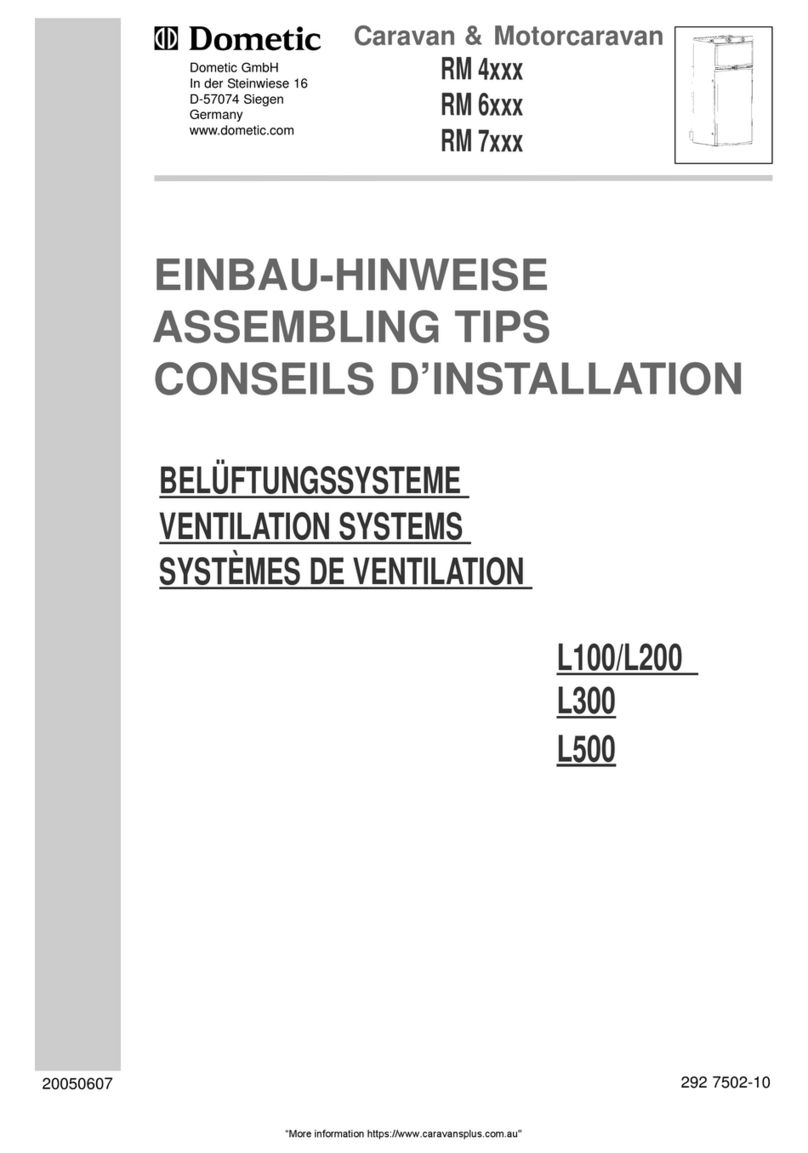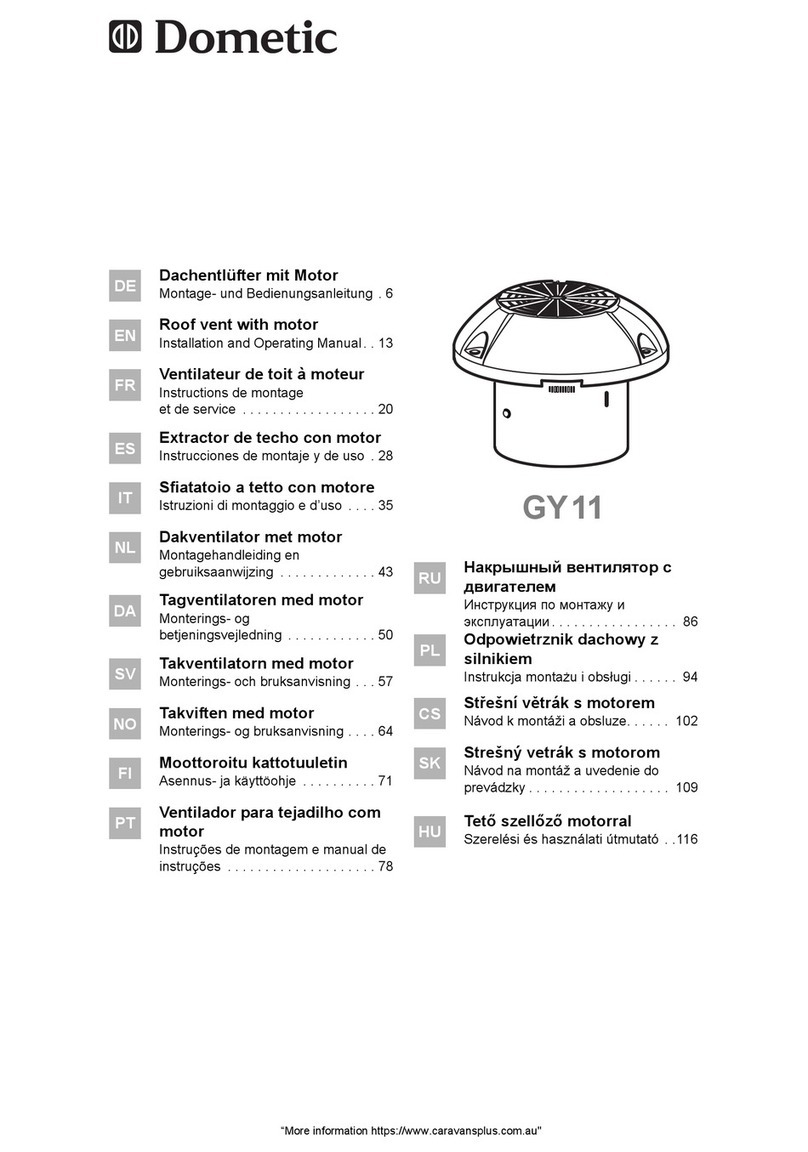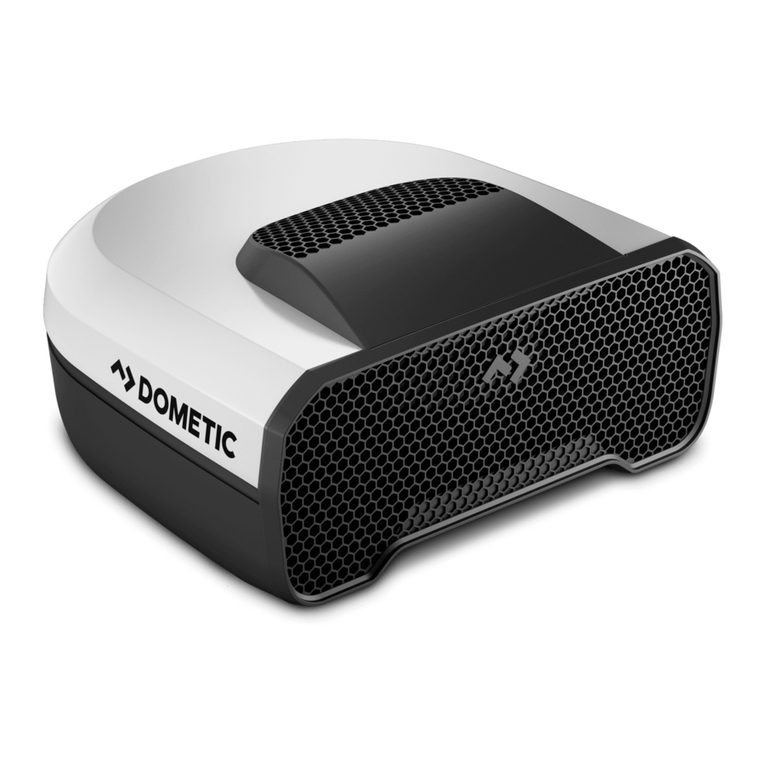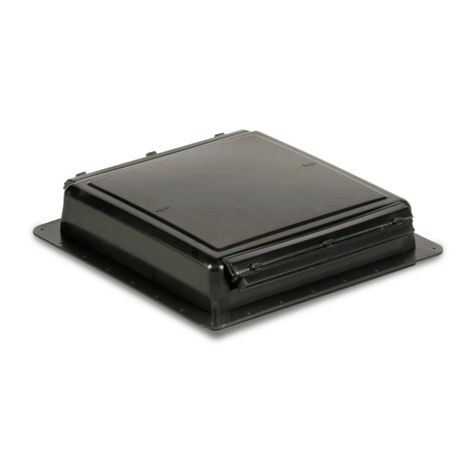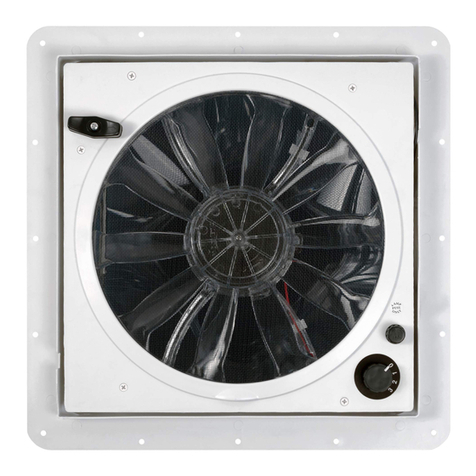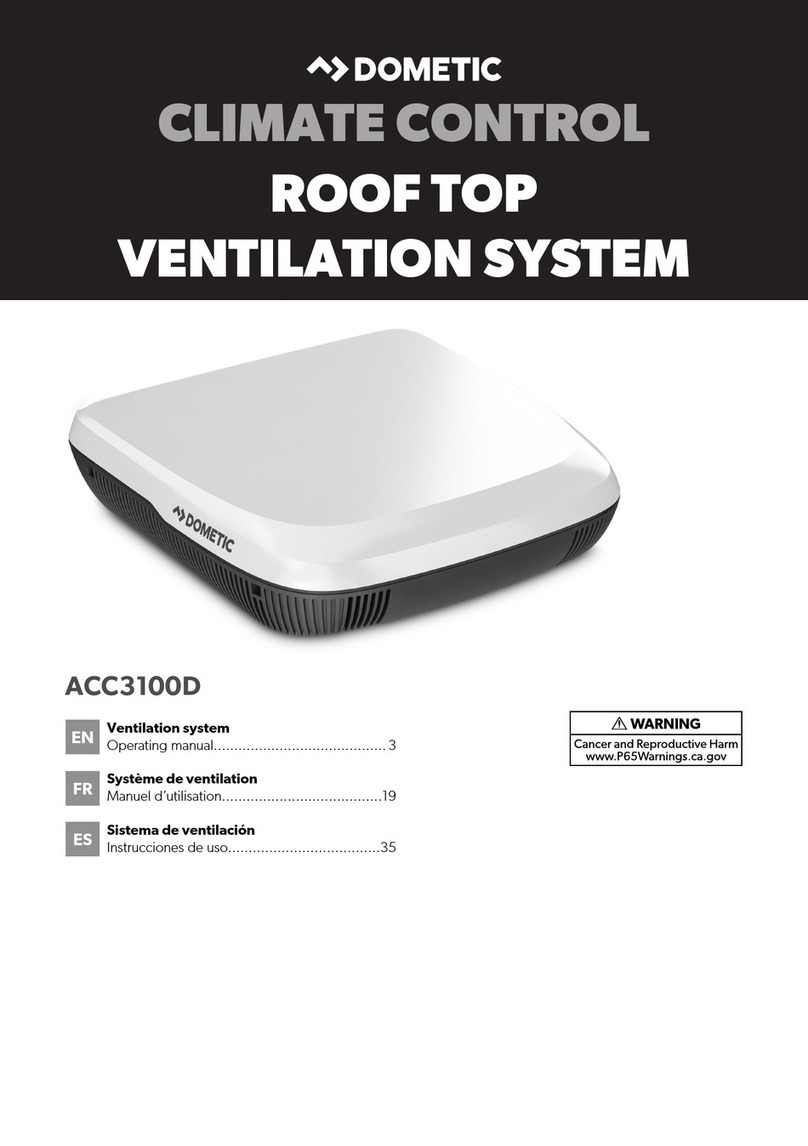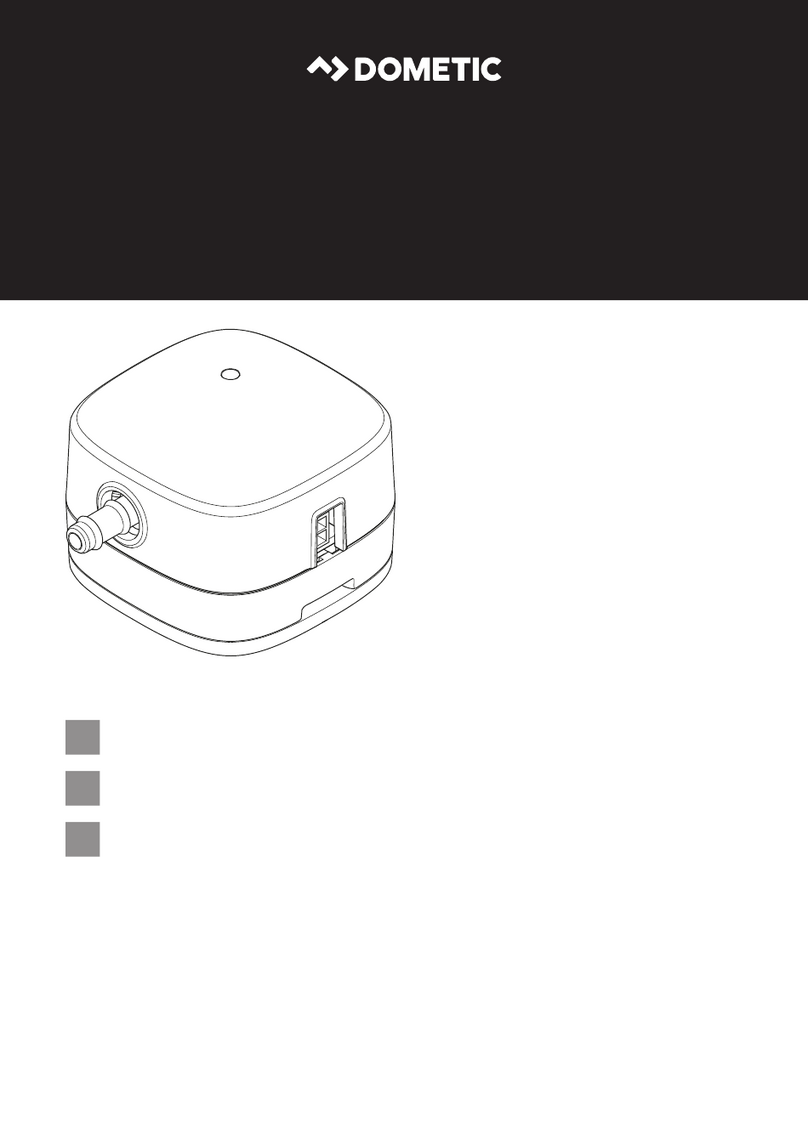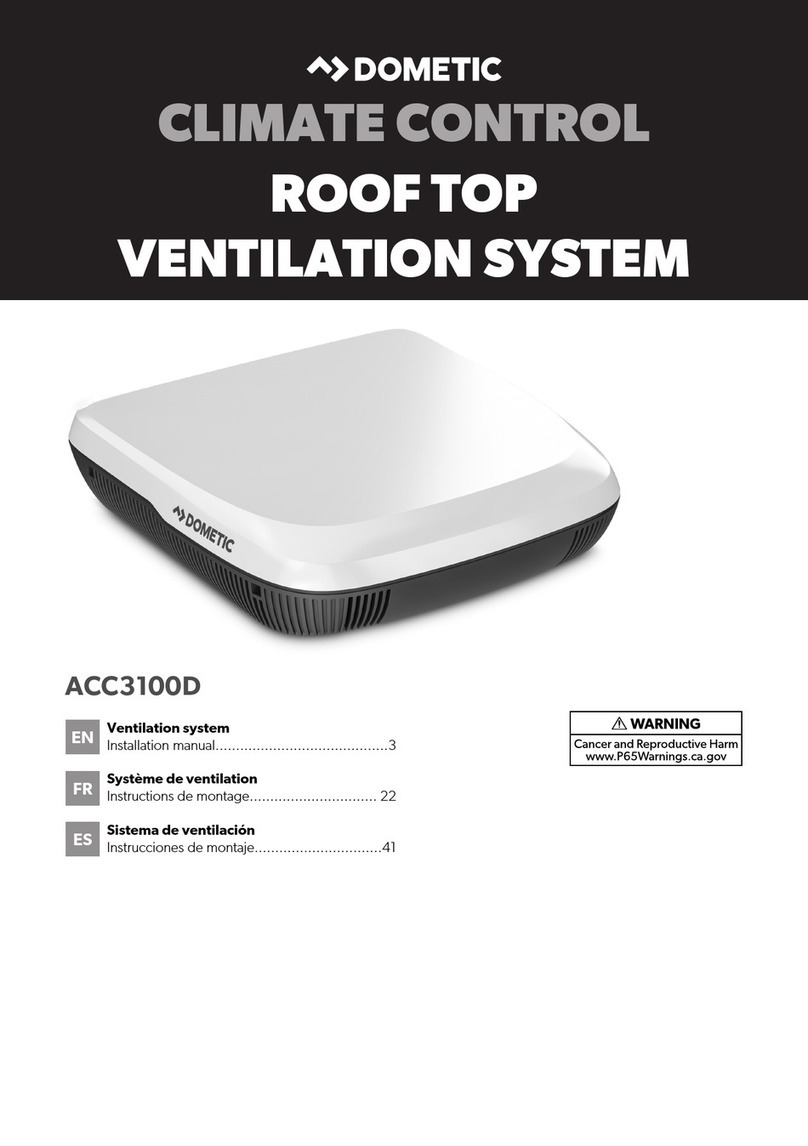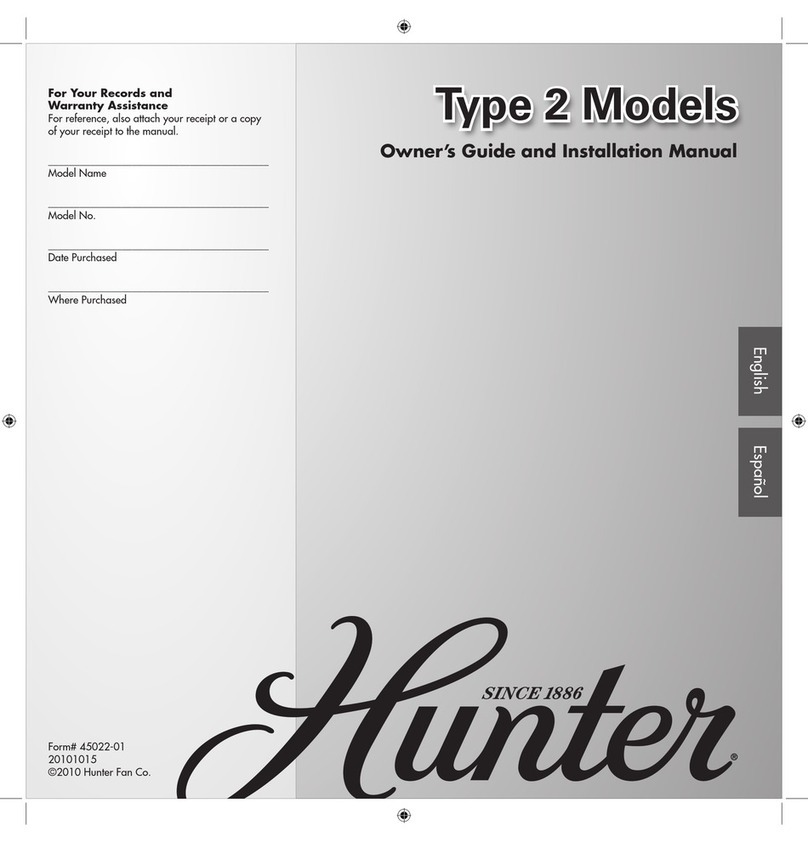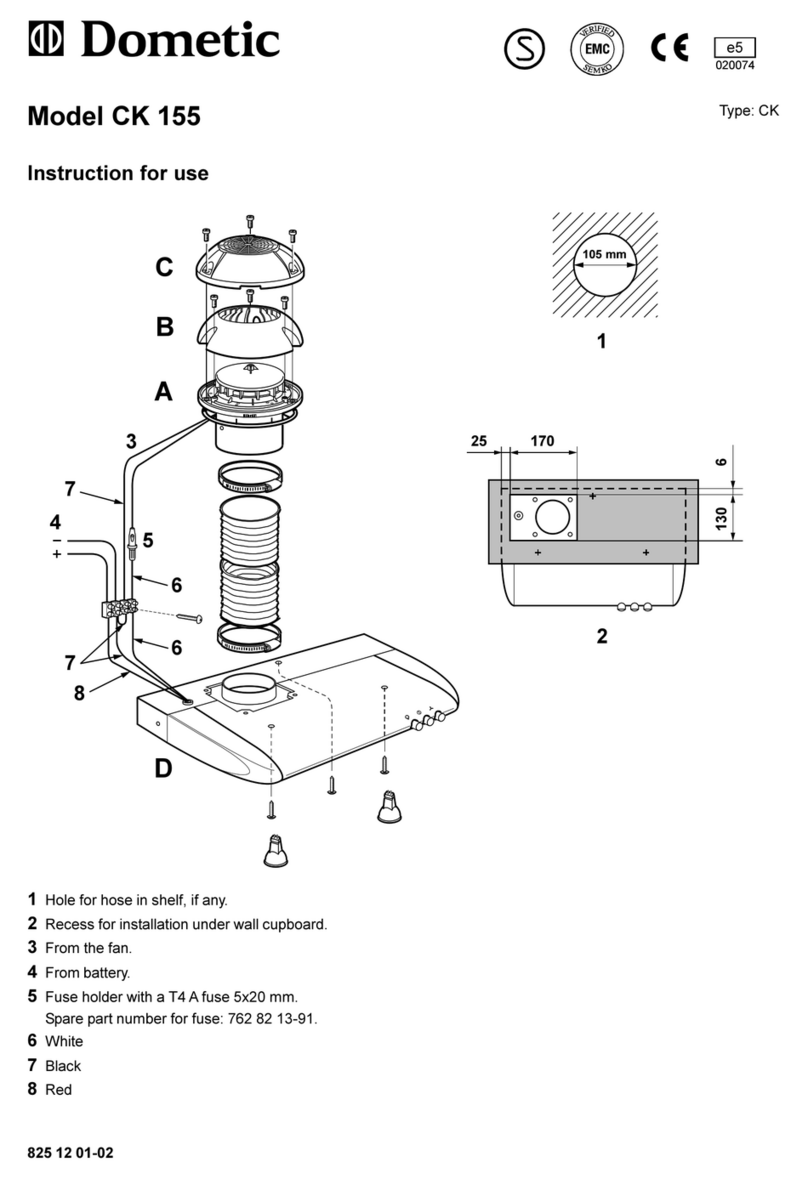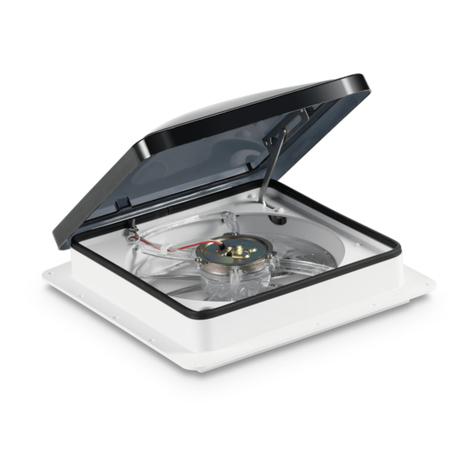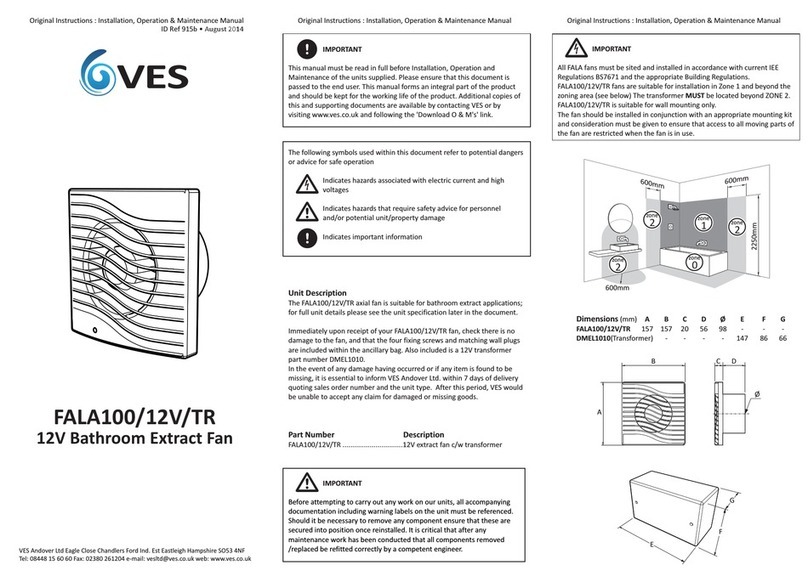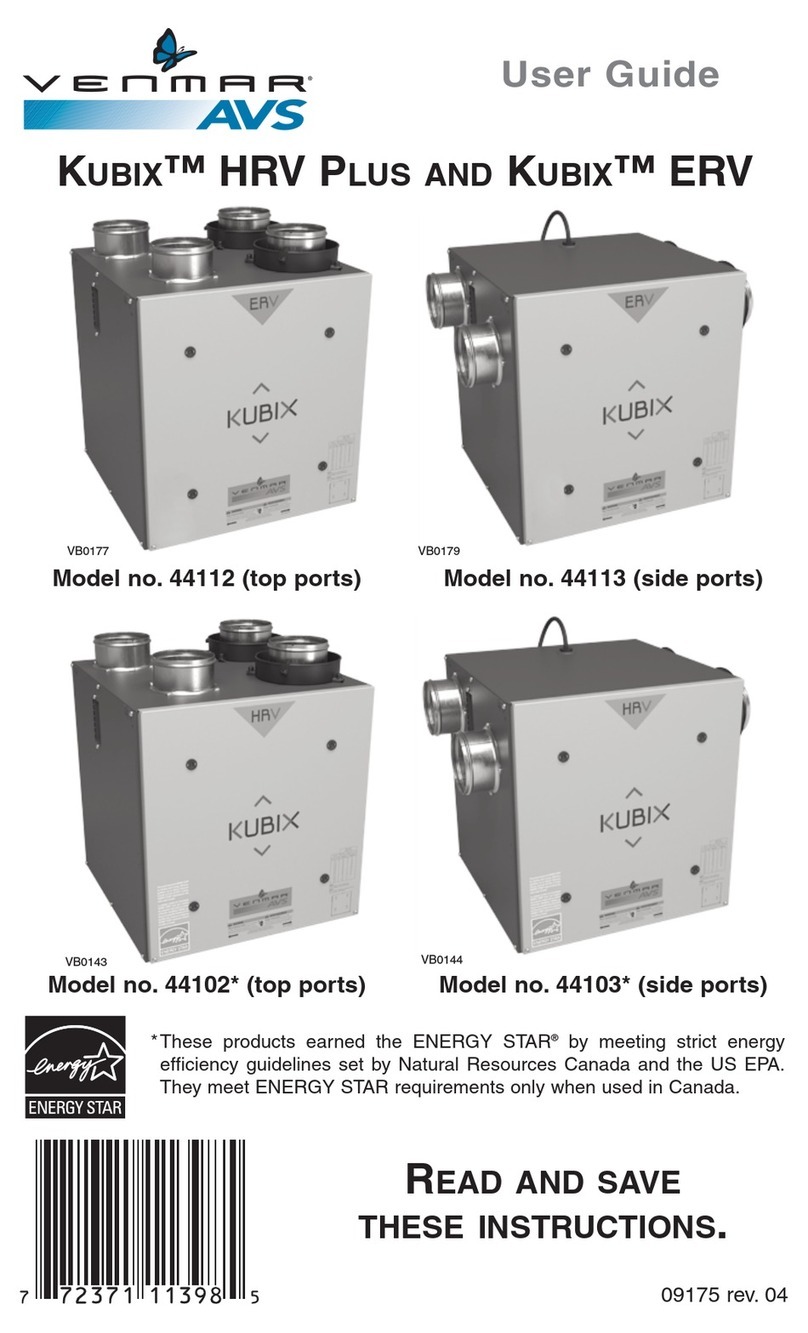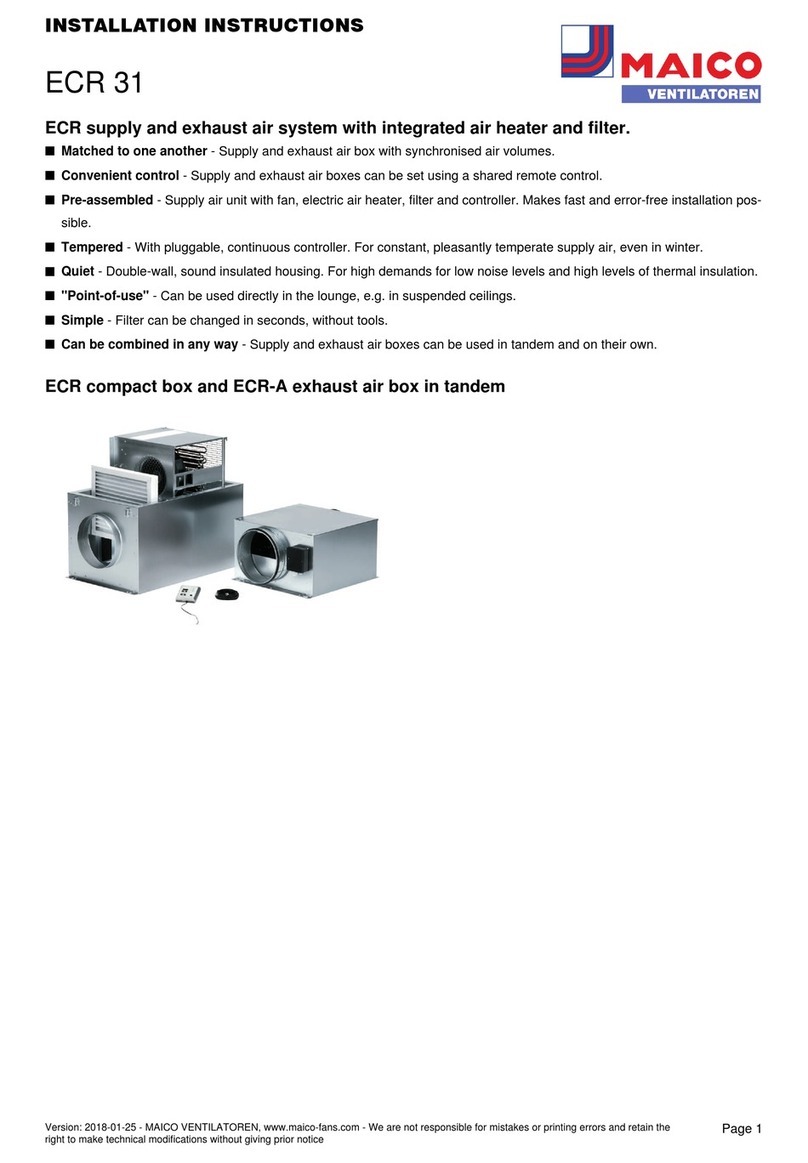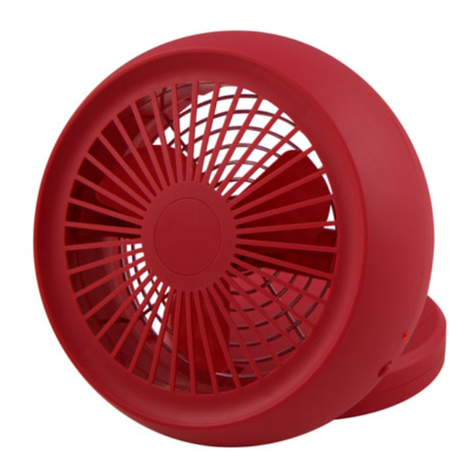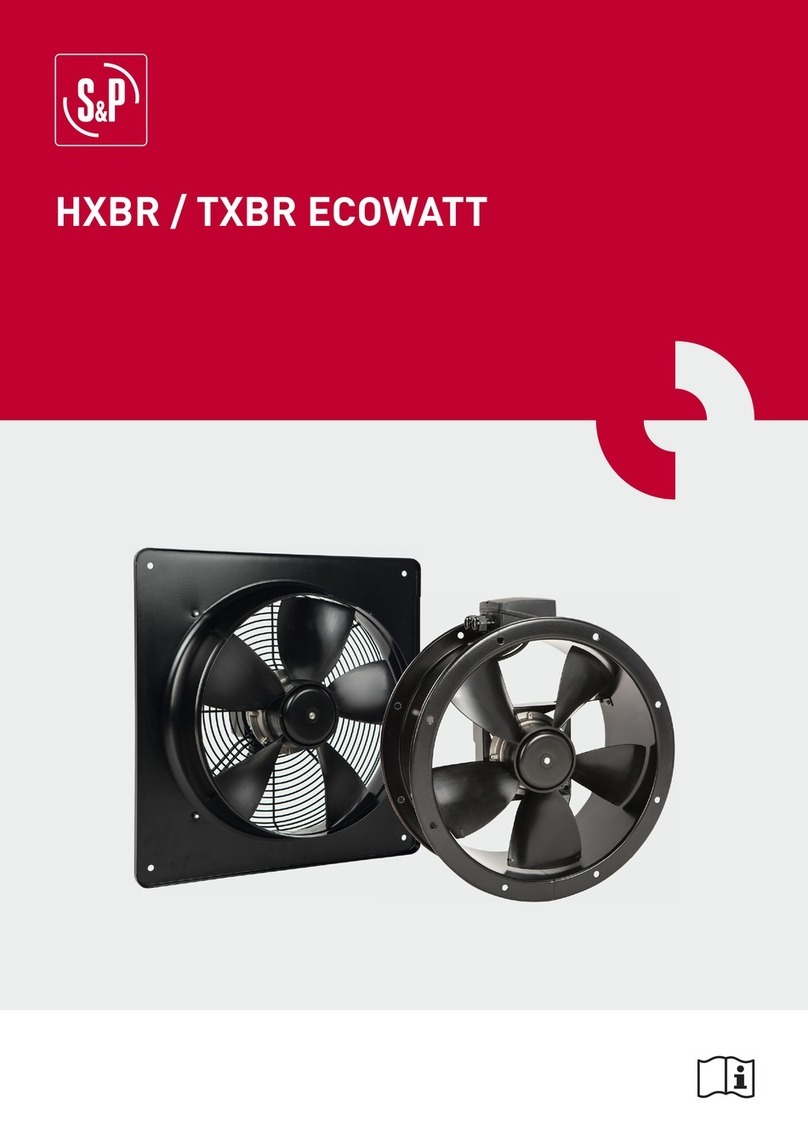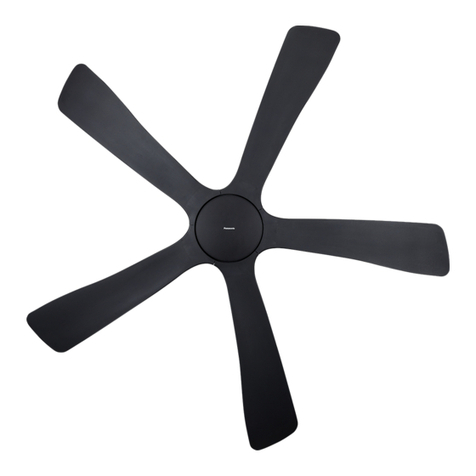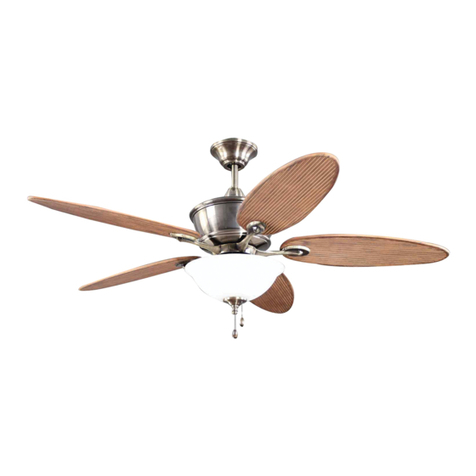
The ventilator should be placed on a surface that is as even and
horizontalaspossible. It shouldbe exposed to the wind regardless
on the direction therefore avoid placing it near to any shelter see
fig. 1.
The ventilator is designed to be used on roofs with a thickness of
25-45 mm. If the roof is thinner the protecting sleeveAand B, see
fig.2, can be cut to the required height, shorter screws of the same
type have to be used.
Make a hole in the roof with a diameter of 130 mm.
Insert the ventilator into the aperture according to fig. 2.
The ventilator has three drainage ports. Always make sure when
fitting the ventilator on a sloping surface that one of the ports is
located at the bottom.
A minimum opening of 60 cm2for the air inlet is necessary some-
where in the ventilated space.
The top of the ventilator is covered by a wire mesh to keep insects
out.In caravans the ventilator should always be open.Onboats
the ventilator may be closed in rough seas.
Flow-through area 43 cm2
Der Ventilator ist auf einer flachen und ebenen Fläche aufzustel-
len. Er muß unabhängig von der Windrichtung, frei windzugängig,
eingebaut sein. Daher darauf achten, daß er nicht neben einem
hochragenden Hindernis positioniert wird (s. Fig. 1).
Der Ventilator ist als Dachlüfter für eine Dachstärke von 25-45 mm
konstruiert.
Bei geringerer Dachstärke können die Muffen A bzw. B entspre-
chend abgekürzt werden (s. Fig. 2). Hier sind kürzere Schrauben
des gleichen Typs zu verwenden.
In das Dach ein Loch von ca. Ø 130 mm schneiden.
Ventilator entsprechend Fig. 2 in dieser Öffnung befestigen. Beim
Befestigen auf einer geneigten Fläche darauf achten, daß eine
der drei Regenablauföffnungen an der tiefsten Stelle sitzt.
An irgendeiner Stelle im Raum muß eine Lufteintrittsöffnung von
mindestens 60 cm2vorhanden sein.
Die Oberseite des Ventilators ist mit einem Fliegendraht abge-
deckt. Der Ventilator muß bei Verwendung in einem Wohnwa-
gen immer geöffnet sein. Auf Schiffen kann der Ventilator bei
rauher See verschlossen werden.
Durchströmfläche 43 cm2
Le ventilateur doit être installé sur une surface aussi plane et de
niveau que possible.
Il doit être exposé aux vents quelque soit leurs directions; évitez
cependant de le placer dans un endroit où il puisse être
atteint par des projections (voir fig. 1).
Le ventilateur est étudié pour être utilisé sur des toits de 25 à 45
mm d’épaisseur.
Si le toit est moins épais il est possible de raccourcir les piècesA
ou B (voir fig. 2) ou les deux si nécessaire. Là, on a besoin des vis
plus courtes de la même façon.
Faites un trou dans le toit d’un diamètre de 130 mm.
Installez le ventilateur dans l’orifice (comme indiqué fig. 2).
Le ventilateur dispose de 3 évacuations d’eau; assurez vous
lorsque vous l’installez sur une surface inclinée qu’une de ces
évacuations est positionnée à la partie la plus basse.
Pour l’aération du véhicule une entrée d’air d’au moins 60 cm2de
section est nécessaire.
Lapartiesupérieureduventilateurestpourvued’une moustiquaire.
Dans le cas d’une caravane, le ventilateur doit toujours être
ouvert; dans le cas d’un bateau le ventilateur doit être fermé par
gros temps.
Surface de passage 43 cm2
The ventilator should be placed on a surface that is as even and
horizontalaspossible. It shouldbe exposed to the wind regardless
on the direction therefore avoid placing it near to any shelter see
fig. 1.
The ventilator is designed to be used on roofs with a thickness of
25-45 mm. If the roof is thinner the protecting sleeveAand B, see
fig.2, can be cut to the required height, shorter screws of the same
type have to be used.
Make a hole in the roof with a diameter of 130 mm.
Insert the ventilator into the aperture according to fig. 2.
The ventilator has three drainage ports. Always make sure when
fitting the ventilator on a sloping surface that one of the ports is
located at the bottom.
A minimum opening of 60 cm2for the air inlet is necessary some-
where in the ventilated space.
The top of the ventilator is covered by a wire mesh to keep insects
out.In caravans the ventilator should always be open.Onboats
the ventilator may be closed in rough seas.
Flow-through area 43 cm2
Der Ventilator ist auf einer flachen und ebenen Fläche aufzustel-
len. Er muß unabhängig von der Windrichtung, frei windzugängig,
eingebaut sein. Daher darauf achten, daß er nicht neben einem
hochragenden Hindernis positioniert wird (s. Fig. 1).
Der Ventilator ist als Dachlüfter für eine Dachstärke von 25-45 mm
konstruiert.
Bei geringerer Dachstärke können die Muffen A bzw. B entspre-
chend abgekürzt werden (s. Fig. 2). Hier sind kürzere Schrauben
des gleichen Typs zu verwenden.
In das Dach ein Loch von ca. Ø 130 mm schneiden.
Ventilator entsprechend Fig. 2 in dieser Öffnung befestigen. Beim
Befestigen auf einer geneigten Fläche darauf achten, daß eine
der drei Regenablauföffnungen an der tiefsten Stelle sitzt.
An irgendeiner Stelle im Raum muß eine Lufteintrittsöffnung von
mindestens 60 cm2vorhanden sein.
Die Oberseite des Ventilators ist mit einem Fliegendraht abge-
deckt. Der Ventilator muß bei Verwendung in einem Wohnwa-
gen immer geöffnet sein. Auf Schiffen kann der Ventilator bei
rauher See verschlossen werden.
Durchströmfläche 43 cm2
Le ventilateur doit être installé sur une surface aussi plane et de
niveau que possible.
Il doit être exposé aux vents quelque soit leurs directions; évitez
cependant de le placer dans un endroit où il puisse être
atteint par des projections (voir fig. 1).
Le ventilateur est étudié pour être utilisé sur des toits de 25 à 45
mm d’épaisseur.
Si le toit est moins épais il est possible de raccourcir les piècesA
ou B (voir fig. 2) ou les deux si nécessaire. Là, on a besoin des vis
plus courtes de la même façon.
Faites un trou dans le toit d’un diamètre de 130 mm.
Installez le ventilateur dans l’orifice (comme indiqué fig. 2).
Le ventilateur dispose de 3 évacuations d’eau; assurez vous
lorsque vous l’installez sur une surface inclinée qu’une de ces
évacuations est positionnée à la partie la plus basse.
Pour l’aération du véhicule une entrée d’air d’au moins 60 cm2de
section est nécessaire.
Lapartiesupérieureduventilateurestpourvued’une moustiquaire.
Dans le cas d’une caravane, le ventilateur doit toujours être
ouvert; dans le cas d’un bateau le ventilateur doit être fermé par
gros temps.
Surface de passage 43 cm2



